
September 24, 2020 – The latest official COVID-19 in Croatia weekly report has been released by the Koronavirus government website, covering September 15-21.
CIPH report for the previous 7 days and daily report for the Republic of Croatia on the 21st of September 2020.
| Tested | Confirmed cases | Active cases | Recovered | Self-isolation | Hospitalized | On a respirator | Deaths | |
| 262.132 (+3268*) | 14992 (+70*) | 2002 | 12737 | 9159 | 297 | 24 (+5*) |
253 (+5*) |
|
| A total of 146 people died in this epidemic wave. Most of the deceased had significant comorbidities or were of advanced age. The average age of the deceased in this epidemic wave is 76.3 years. Sixty-two people died on a respirator. * in the last 24 hours |
||||||||
There are currently 22 testing places in the Republic of Croatia that perform RT-PCR analysis and collect samples. All processed samples enter national Croatian Health Insurance Institute platform, which is accessible to all county public health institutes. County public health institutes submit data about positive cases, sources of infection and hotspots as part of their daily reports to the Croatian Institute of Public Health. The Croatian Institute of Public Health collects information about hotspots, hospital treatment of COVID-19 positive persons, COVID-19 positive patients on respirators and the deceased. You can find more about the test centers on the link.
Epidemiological indicators on 21st of September:
- Cumulative 7-day incidence rate for the Republic of Croatia: 34,1/100 000
- Cumulative 14-day incidence rate for the Republic of Croatia: 71,2/100 000
- Counties with a cumulative 7-day incidence rate greater than 50/100 000 inhabitants: Brodsko-posavska, Karlovačka, Ličko-senjska, Požeško-slavonska, Splitsko-dalmatinska
- Counties with a cumulative 14-day incidence rate greater than 100/100 000 inhabitants: Brodsko-posavska, Dubrovačko-neretvanska, Ličko-senjska, Požeško-slavonska, Splitsko-dalmatinska, Virovitičko-podravska
- Total number of tests in the last week: 37 118
- Share of positive tests in the total number of tests in the last week: 3,8 %
- Total number of tests and share of positive tests in total number of tests: 262 132, 5,7 %
- The number of new cases in intensive care per 100,000 inhabitants in the last 7 days: 0,49/100 000
- Number of deaths in the last week: 26
- Total death rate per 1 000 000 population: 61,9/1 000 000
Epidemiological situation in Croatia
Geographical distribution of new COVID-19 cases by counties
In a two-week period from 8th of September to 21st of September all counties recorded new cases of COVID-19 disease. The highest number of new cases are recorded in the Splitsko – dalmatinska County, followed by the City of Zagreb and Zadarska County. The lowest number of new cases were recorded in Koprivničko – križevačka and Varaždinska County. The Požeško – slavonska County also has the highest 14-day rate, followed by Splitsko – dalmatinska and Ličko – senjska County.
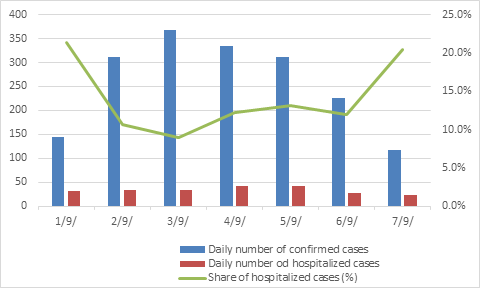
Epidemic by weeks, from 19 th – 30 th week of the epidemic
Table 1 shows the epidemiological indicators by epidemic week. The data shows that one of the most important epidemiological indicators, the rate of confirmed cases, the number of tests and the share of positive ones show a positive trend in the last 4 weeks. The confirmed case rate has been steadily declining since week 27 when it stood at 47.6 to 34 at week 30. The total number of tests has been growing continuously for the past 5 weeks, i.e. from the 25 th week. The proportion of positive people in total testing also fell steadily, falling from 12.5 in the 26 th week of the epidemic to 3.8 in the 30 th week.
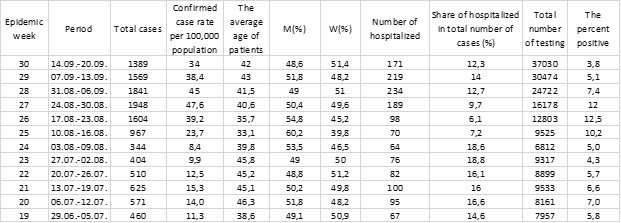
Table 1. Overview of the number of confirmed cases by weeks, from week 19 th –30th
Table 2 shows a set of indicators related to the severity of the clinical picture and the characteristics of deaths. The table shows that in the last 3 weeks there has been an increase in the average age of cases, the number of cases on the respirator and the death rate, which corresponds to previous findings that older people are more likely to develop more severe clinical forms and higher mortality in older age groups.

Table 2. Overview of patients on respirator and deaths by weeks, from week 19 th – 30th
Table 3 shows the incidence of the 7-day rate over the last three weeks with a limit of 50/100 000 inhabitants, which in some countries is taken as one of the criteria in assessing the epidemiological situation. In most counties, the 7-day rate is generally stable or slightly declining.
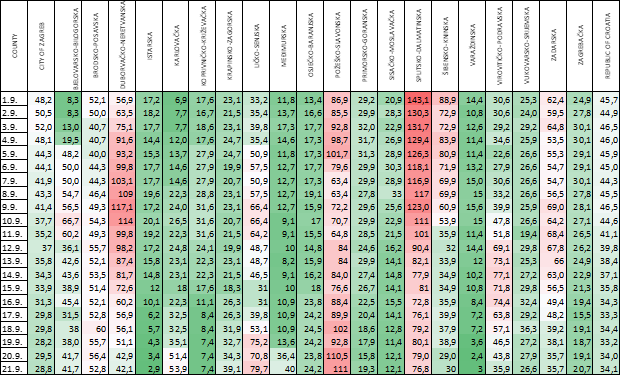
Table 3. Overview of 7-day incidence rates per 100,000 population in the last week
Clinical aspects – hospitalized, on a respirator and cured in the last week
Figure 2 shows the relationship between the daily number of confirmed cases and the daily number of hospitalized cases. Number of hospitalized cases per day ranged between a minimum of 17 and a maximum of 35, while the share of hospitalized cases in the total daily number of confirmed cases ranged from 7.3% to 42.9%.

Figure 2. Overview of the daily number of confirmed and hospitalized cases (15.9.-21.9.)
Figure 3 shows the proportion of hospitalized in the total number of weekly cases. Of the total number of confirmed cases in a given weekly period, 13.2% were hospitalized. In the same period, 20 people were put on a respirator, which makes 1,4% of the total number of confirmed cases.
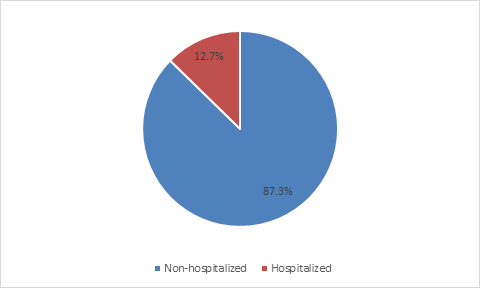
Figure 3. Relation of the total number of confirmed and hospitalized cases (15.9.-21.9.)
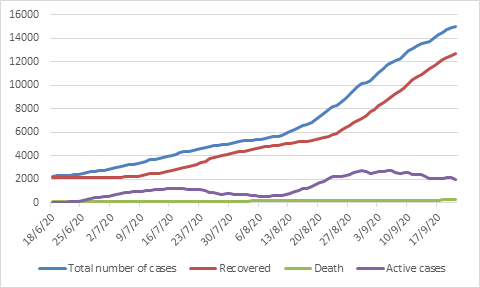
Figure 4. Movement of the total number of cases, recovered, deceased and active number of cases from 18.6.- 21.9.
Died from COVID-19,15 th of September – 21st of September 2020, age and sex
A total of 146 people died in this wave of epidemics. Most of the people who died had significant comorbidities or were of advanced age. The mean age of the deceased in this wave of epidemics is 76.3 years. Sixty-two people died on a respirator.
An overview of the situation is given in Table 4 and Figure 5.
Table 4. Distribution by age and sex of the deceased people
| AGE GROUP | 40-49 | 50-59 | 60-69 | 70-79 | 80-89 | 90-99 | 100+ |
| MEN | 1 | 10 | 17 | 32 | 21 | 4 | 1 |
| WOMEN | 0 | 0 | 9 | 15 | 30 | 6 | 0 |
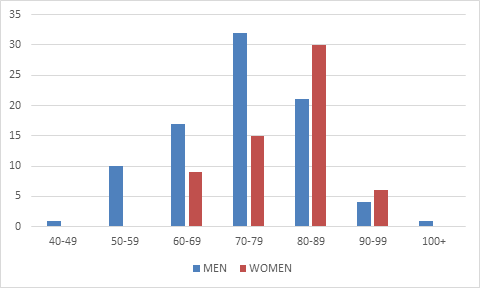
Figure 5. Age and sex distribution of deaths from COVID-19 in the period 29 th June – 21st of September 2020
In the last week, 26 people died, of which 14 (53.8%) were on a respirator. The distribution by age and sex in the last weeks is shown in Table 5, and by counties in Table 6.
Table 5. Distribution by age and sex of the deceased people in the last week
| AGE GROUP | 50-59 | 60-69 | 70-79 | 80-89 | 90-99 |
| MEN | 3 | 2 | 2 | 4 | 0 |
| WOMEN | 0 | 3 | 6 | 5 | 1 |
Hotspots
Table 6. New ill and deceased cases in the last week and total deaths and rates
| County | Number of new cases in the period 15.9.-21.9. | Incidence of new cases in the last 7 days on 100 000 inhabitants |
Number of deaths in the period 15.9.-21.9. | Total number of deaths | Total mortality rate on 1,000,000 inhabitants |
|
| CITY OF ZAGREB | 232 | 28,8 | 6 | 39 | 48,5 | |
| BJELOVARSKO-BILOGORSKA COUNTY | 45 | 41,7 | 0 | 1 | 9,3 | |
| BRODSKO-POSAVSKA COUNTY | 74 | 52,8 | 0 | 4 | 28,6 | |
| DUBROVAČKO-NERETVANSKA COUNTY | 51 | 42,1 | 2 | 12 | 99,0 | |
| ISTARSKA COUNTY | 6 | 2,9 | 1 | 13 | 62,3 | |
| KARLOVAČKA COUNTY | 63 | 53,9 | 0 | 2 | 17,1 | |
| KOPRIVNIČKO-KRIŽEVAČKA COUNTY | 8 | 7,4 | 0 | 16 | 148,5 | |
| KRAPINSKO-ZAGORSKA COUNTY | 49 | 39,1 | 0 | 2 | 16,0 | |
| LIČKO-SENJSKA COUNTY | 36 | 79,7 | 0 | 1 | 22,1 | |
| MEĐIMURSKA COUNTY | 44 | 40,0 | 0 | 0 | 0,0 | |
| OSJEČKO-BARANJSKA COUNTY | 67 | 24,2 | 2 | 26 | 93,8 | |
| POŽEŠKO-SLAVONSKA COUNTY | 75 | 110,5 | 1 | 4 | 58,9 | |
| PRIMORSKO-GORANSKA COUNTY | 55 | 19,3 | 1 | 4 | 14,1 | |
| SISAČKO-MOSLAVAČKA COUNTY | 18 | 12,1 | 2 | 5 | 33,6 | |
| SPLITSKO-DALMATINSKA COUNTY | 344 | 76,8 | 2 | 67 | 149,5 | |
| ŠIBENSKO-KNINSKA COUNTY | 30 | 30,0 | 1 | 7 | 69,9 | |
| VARAŽDINSKA COUNTY | 5 | 3,0 | 0 | 3 | 18,0 | |
| VIROVITIČKO-PODRAVSKA COUNTY | 27 | 35,9 | 4 | 7 | 93,0 | |
| VUKOVARSKO-SRIJEMSKA COUNTY | 41 | 26,6 | 2 | 16 | 103,6 | |
| ZADARSKA COUNTY | 60 | 35,7 | 0 | 7 | 41,6 | |
| ZAGREBAČKA COUNTY | 64 | 20,7 | 2 | 17 | 54,9 | |
| REPUBLIC OF CROATIA | 1394 | 34,1 | 26 | 253 | 61,9 | |
Continental Croatia
In the last week, new cases were recorded in all counties of continental Croatia, but mostly in the City of Zagreb, Požeško – slavonska and Brodsko – posavska County. The highest 7-day rates on 14 th of September were in Požeško – slavonska, Virovitičko – podravska and Brodsko – posavska County. In the last week, due to the appearance of new hotspots, a significant increase in the number of patients has been recorded in Karlovačka and Međimurska County. In Karlovačka County, a large number of patients are associated with activities related to choral singing, while in Međimurska County, the grouping of patients is associated with weddings. In Brodsko – posavska, Virovitičko – podravska and Zagrebačka County, groups of patients related to weddings are also recorded. This week, a smaller number of patients was recorded in connection with the prom party in Požeško – slavonska County and the home for the elderly in Sisačko – moslavačka County. Smaller groupings of patients associated with the spread of the disease in the workplace were recorded in several counties, while a larger grouping in the workplace, which currently records contacts, appeared in Krapinsko – zagorska County. Cases of the disease have also occurred in schools, but there has been no significant spread among students and staff. Cases of illness after returning from vacation are still recorded. Part of the sick people are cases imported from abroad and there is a large proportion of contacts of sick people.
Coastal Croatia
Cases of ill persons have been recorded in Coastal Croatia like in all counties as well. The highest number of patients was recorded in the Splitsko – dalmatinska, Zadarska and Primorsko – goranska County. The highest 7-day rate is in the Ličko – senjska, Splitsko – dalmatinska and Dubrovačko – neretvanska County. In most counties, after the end of the tourist season, the number of patients decreases again. In the Splitsko – dalmatinska County, there were also groupings related to choral singing and several smaller groupings related to the spread of the disease in the workplace. Related to the workplace, there have been also outbreaks reported in other coastal counties, but most of the contacts were immediately placed under health surveillance, so there wasn’t reported greater number of cases. As in the continental part, the cases of the disease were confirmed in several schools, but there wasn’t greater spread observed among students and staff. A significant proportion of patients are contacts of previously recorded cases.
Age-sex distribution of patients in the last week
In the previous week, a total of 1,394 people fell ill – approximately the same number of females (51.6%) and males. The same distribution by sex is present in most age groups, except in the age groups under the 7 years, where is the smallest number of patients and in the age group 51-65, in which women predominate (56.4%).
By age groups – 187 children fell ill and the 185 people of older age, which makes an equal percentage in the total number of patients, or 13%. The least affected were children under 1 year of age, a total of 2. The most affected were children of secondary school age, a total of 75. Adults made the largest share in the total number of patients last week 1022 (73.3%).
The distribution of patients by age did not change significantly compared to last week, except for a slight increase in children from 10.5% to 13.4%.
The full view can be found in Figure 6 and Table 6.
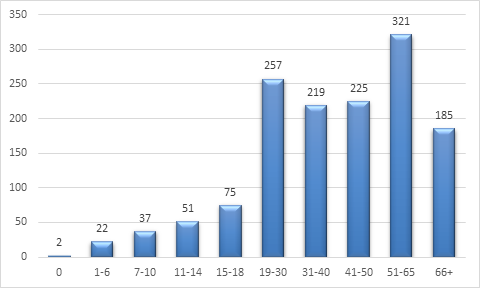
Figure 6. Distribution of patients in the last week by age groups
Table 6. Age and sex distribution of patients in the period 15.9.-21.9.2020
| Category | Age group | Number of cases men | Share of men (%) | Number of cases women | Share of women (%) | Total by age groups and categories | Share of age groups and categories in the total number of cases (%) | ||
| Kids | 0 | 2 | 100,0% | 0 | 0,0% | 2 | 187 | 0,1% | 13,4% |
| 1-6 | 6 | 27,3% | 16 | 72,7% | 22 | 1,6% | |||
| 7-10 | 17 | 45,9% | 20 | 54,1% | 37 | 2,7% | |||
| 11-14 | 25 | 49,0% | 26 | 51,0% | 51 | 3,7% | |||
| 15-18 | 34 | 45,3% | 41 | 54,7% | 75 | 5,4% | |||
| Adults | 19-30 | 133 | 51,8% | 124 | 48,2% | 257 | 1022 | 18,4% | 73,3% |
| 31-40 | 119 | 54,3% | 100 | 45,7% | 219 | 15,7% | |||
| 41-50 | 108 | 48,0% | 117 | 52,0% | 225 | 16,1% | |||
| 51-65 | 140 | 43,6% | 181 | 56,4% | 321 | 23,0% | |||
| Elders | 66+ | 90 | 48,6% | 95 | 51,4% | 185 | 185 | 13,3% | 13,3% |
| TOTAL | 674 | 48,4% | 720 | 51,6% | 1394 | 100,0% | |||
Measures
Measures to maintain physical distance, maintain hand hygiene and disinfection are still in force. Also, it is mandatory to wear face masks or medical masks indoors for all health workers and professionals, employees who work in social care system and the ones who work in hospitality facilities
Decisions of the Headquarters
- September 2 – Decision about the introduction of necessary epidemiological measures for the Sisačko – moslavačka County
- September 2 – Decision about the introduction of necessary epidemiological measures for the area of Požeško – slavonska County
- September 2 – Decision about the introduction of necessary epidemiological measures for the area of Koprivničko – križevačka County
- September 3 – Decision about the necessary measure of enhanced control of the implementation of the Guidelines for the Prevention and Suppression of the COVID-19 Epidemic for Social Service Providers in the Social Welfare System
- September 3 – Decision about the introduction of necessary epidemiological measures for the Krapinsko – zagorska County
- September 5 – Decision about the introduction of necessary epidemiological measures for the Bjelovarsko – bilogorska County
- September 7 – Decision amending the Decision on the necessary measure of limiting the working hours of catering facilities in the category “Bars”
- September 8 – Decision about amendments to the Decision about the introduction of necessary epidemiological measures for the Brodsko – posavska County
- September 8 – Decision about the introduction of new epidemiological measures for the area of the City of Otočac
- September 9 – Decision about amendments to the Decision about the introduction of necessary epidemiological measures for the area of Zadarska County
- September 9 – Decision amending the Decision about the introduction of necessary epidemiological measures for the area of Splitsko – dalmatinska County
- September 11 – Decision amending the Decision about the introduction of necessary epidemiological measures for the area of Dubrovačko – neretvanska County
- September 11 – Decision about the introduction of necessary epidemiological measures for the area of Virovitičko – podravska County
- September 11 – Decision about the introduction of necessary epidemiological measures for the Zagrebačka County
- September 14 – Decision amending the Decision about the temporary ban on crossing the border crossings of the Republic of Croatia
- September 14 – Decision amending the Decision about the introduction of necessary epidemiological measures for the Krapinsko – zagorska County
- September 14 – Decision amending the Decision about the introduction of necessary epidemiological measures for the area of Šibensko – kninska County
- September 21 – Decision about the introduction of necessary epidemiological measures for the Ličko – senjska County
CIPH recommendations
- Diseases and health conditions that may increase the risk for more severe forms of COVID-19 disease
- Selected health and organizational issues related to the work of preschool institutions, primary and secondary schools in the school year 2020/2021
- Recommendations for teaching at higher education institutions in the period of the COVID-19 pandemic with the application of anti-epidemic measures
- Organization of rest and food – Work of preschool institutions, primary and secondary schools in the school year 2020/2021 – additional clarifications
- Visors cannot replace masks except when a student / person has a problem with hearing impairment – Work of preschool institutions, primary and secondary schools in the school year 2020/2021 – additional clarifications
- Criteria for testing for SARS-CoV-2, termination of isolation and quarantine – Unified revised recommendations about priorities for testing for SARS-CoV-2, handling of contacts, termination of isolation and quarantine (“self-isolation”)
- Terms of use of school sports halls by external users
- Instructions for the work of student dormitories with regard to the COVID-19 epidemic in the school year 2020/2021.
- Instructions for the prevention and control of the COVID-19 epidemic in student dormitories with regard to the COVID-19 epidemic in the school year 2020/2021.
Recommendations and measures on global and EU level
Europe
On 10 th of August 2020, ECDC released an updated version of the risk assessment:
ECDC has additional documents and information available: https://www.ecdc.europa.eu/en and https://www.ecdc.europa.eu/en/covid-19-pandemic
The number of cases and the 7-day cumulative incidence of COVID-19 confirmed cases worldwide can be found on the ECDC dashboard: https://qap.ecdc.europa.eu/public/extensions/COVID-19/COVID-19.html
Austria
Bundesministerium für Soziales, Gesundheit, Pflege und Konsumentenschutz – https://www.sozialministerium.at/Informationen-zum-Coronavirus/Neuartiges-Coronavirus-(2019-nCov).html
Netherlands
Government of the Netherlands – https://www.government.nl/topics/coronavirus-covid-19
National Institute for Public Health and the Environment – https://www.rivm.nl/en/novel-coronavirus-covid-19
Germany
Rober Koch Institut – https://www.rki.de/DE/Home/homepage_node.html
Slovenia
(gov.si) – https://www.gov.si/en/topics/coronavirus-disease-covid-19/
National Institute for Public Health – Slovenia – https://www.nijz.si/en
United Kingdom
gov.uk – https://www.gov.uk/coronavirus
NHS – https://www.nhs.uk/conditions/coronavirus-covid-19/
World
WHO provides comprehensive information and documents
WHO COVID-19-Dashboard: https://covid19.who.int/ and https://www.who.int/emergencies/diseases/novel-coronavirus-2019
Coronavirus disease (COVID-19) Weekly Epidemiological Update and Weekly Operational Update i Weekly Surveillance Report: https://www.who.int/emergencies/diseases/novel-coronavirus-2019/situation-reports and https://www.euro.who.int/en/health-topics/health-emergencies/coronavirus-covid-19/weekly-surveillance-report
Sources of information
https://www.hzjz.hr/
https://zdravlje.gov.hr/
Information about the global epidemiological situation
More about COVID-19 in other countries can be found and learned on the ECDC website: https://www.ecdc.europa.eu/en/geographical-distribution-2019-ncov-cases. The WHO Regional Office for Europe, the European Commission and the European Observatory on Health Systems and Health Policy have at their disposal the COVID-19 Health System Response Monitor (HSRM). There is information available about European countries and ways to respond to this epidemic. The focus is on health systems and public initiatives: https://www.covid19healthsystem.org/mainpage.aspx
For the latest travel info, bookmark our main travel info article, which is updated daily.
Read the Croatian Travel Update in your language – now available in 24 languages!
Join the Total Croatia Travel INFO Viber community.











